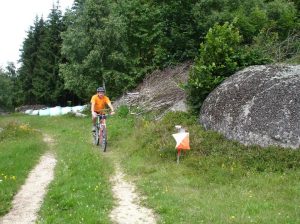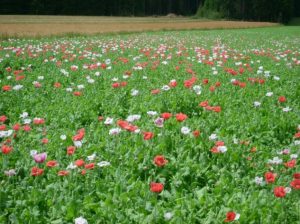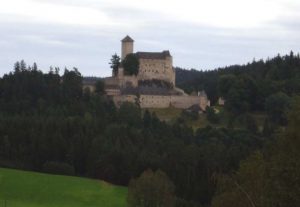WALDVIERTEL – Austria’s “holiday district”
The Waldviertel – a nature experience as far as the eye can see
The Waldviertel (literally: “forest district”) stretches over 4,600 square kilometres. The Danube separates it from the Lower Austrian Mostviertel in the south – and if you travel clockwise to the east, the Upper Austrian Mühlviertel, the Czech South Bohemia and finally the mountain Manhartsberg as well as the Lower Austrian Weinviertel form the remaining boundaries. But enough of boundaries – nature in the Waldviertel knows no limits! The large expanses of forest shape the landscape with impressive shades of green or fabulous autumnal colours. Pines, birch, spruce, oaks, beech and fir trees line the hiking paths and cycling trails. They spread over to the natural riverbanks of the Thaya, the Kamp or the dams, lead up to one-thousand-metre peaks such as the “Tischberg” or the “Great Peilstein” and open up to reveal unspoiled grasslands, meadows and hilly vineyards. Over the course of a 900-year history of settlement, a small-scale agriculture emerged in these unique forest landscapes: Today you will find the purple-red seas of poppy blossoms here, dark green potato fields, golden yellow vineyards and rye fields as well as hundreds of carp ponds.
The Waldviertel – one of Lower Austria’s cultural treasures
Obviously, a unique culture has always been “flourishing” in the Waldviertel. Some former fortified medieval castles have been transformed into impressive castles. Two remarkable examples are well worth a visit: Rosenburg Renaissance Castle and Pöggstall Castle, the host of the 2017 Lower Austrian regional Exhibition. It was, above all, the Renaissance that gave the region’s numerous castles their magnificent appearance: Rosenau Castle, Weitra Castle or Ottenstein Castle – the beauty and aesthetics of the Renaissance are still present in the Waldviertel today. However, many other art eras also provide grand encounters: Grafenegg Castle is, undoubtedly, one of the most beautiful monuments of romantic historicism in Austria. Moreover, Altenburg Monastery boasts a splendid baroque air. “Architecture and spirituality” are outstanding hosts, not only in the Cistercian Monastery of Zwettl and Geras Monastery, but also in Pernegg Monastery and the pilgrimage church of Maria Dreieichen. Yes, even the gates to the Middle Ages are open to guests who wish to visit the historical “walled towns” of Waidhofen an der Thaya, Weitra, Zwettl, Horn, Eggenburg and Drosendorf. The same applies to the castles in Gars, Rappottenstein, Heidenreichstein, Hardegg and Raabs as well as to the ruins of Lichtenfels, Kollmitz and Arbesbach.
From its castles, monasteries, churches, fortresses to its ruins and museums – the Waldviertel bears witness to a great cultural history. A cultural history that is carefully nurtured and that is still, today, full of artistic life, thanks to concerts, operas and operettas, plays, readings and exhibitions.
The Waldviertel – where hikers wear “seven-league boots”, cyclists get into gear and guests’ health goes uphill again
„Das Wandern ist der Waldviertler Lust“ (“Hiking is the Waldviertlers’ delight”) is a loose interpretation of the musical poem “Das Wandern ist des Müllers Lust” (“Hiking is the miller’s delight”). Hundreds of hiking trails and thousands of kilometres lead guests through the natural setting of the Waldviertel, from the untouched natural parks of “Hochmoor Schrems”, “Nordwald”, “Heidenreichsteiner Moor”, “Kamptal-Schönberg”, “Nordwald”, “Dobersberg” and “Geras” to “Blockheide Gmünd”, where you can marvel at the legendary stone formations and rocking stones. The banks of the Thaya accompany outdoor enthusiasts through the Thaya Valley. With a bit of luck, you can even spot a wildcat in the “Thaya Valley Nature Park”, while a “long-distance hiking trail” over 180 kilometres leads you from Nebelstein to Retz.
Visitors to the region of “Kamptal-Manhartsberg” are rewarded with “golden yellow views”: Some 2,000 hectares of vineyards grow around the wine capital of Langenlois alone, where it is a must to “taste” the “WINE TRAIL Langenlois”. Additionally, keen gardeners are in for a treat in Schiltern: the relaxing GARTEN TRAIL combines both the unique, colourful “Kittenberger Adventure Gardens” and an Austrian rarity – the show gardens of NOAH’S ARK.
Exploring the region “The Heart of the Waldviertel” on foot is also a great pleasure: Old ponds and lumberjack settlements await guests here. The reservoirs of Ottenstein, Thurnberg and Dobra tempt you to enjoy round trips, canoe rides or summer refreshments. The journey continues in the breathtaking Southern Waldviertel where footbridges take you right into the thundering gorge of the Ysper creek, stretching for four kilometres. No doubt about it, hikers have “seven-league boots” in the Waldviertel! But there is plenty on offer for cyclists and mountain bikers, too. The “Kamp-Thaya-March Bicycle Trail” extends over 420 kilometres – and even the infamous 9,000-kilometre “Iron Curtain Trail” leads through exciting regions in the Waldviertel. In winter, cross-country skis are a must in the Waldviertel. Discover the crisp sporting world of Bärnkopf, Gutenbrunn and Martinsberg as well as Bad Traunstein, Ottenschlag and Gföhl, Hirschenwies, St. Leonhard and St. Oswald and feel your cares slip away. All year round, spring, summer, autumn or winter, sport is always in season in the Waldviertel. Be it hiking, cycling, mountain biking, swimming, canoeing, climbing or golfing: sportspeople always hit the bull’s eye here! Of course, the sheer variety of natural sporting highlights boosts our guests’ state of health as well. The “Moorheilbad Harbach”, the “Cardiovascular Centre of Groß Gerungs”, the “Lebens.Resort Ottenschlag”, the “la pura women’s health resort”, the “Gesundheitshotel Klosterberg” and the “Moorbad Großpertholz” are the places to go.
The Waldviertel – mouthwatering taste sensations for guests
Poppy blossoms, herbal gardens, rye and potato fields, climbing hops, damson trees and carp ponds – nature and regional farmers demonstrate their culinary skills in the Waldviertel. It is the perfect place to enjoy visual feasts in restaurants and hotels as well as in one of the numerous local shops serving traditional cuisine. Thanks to the initiative of the company WALDLAND, one example is the great poppy culture of the Waldviertel, which is blossoming again in the fields and kitchens. A whole village – the “Mohndorf (Poppy Village) of Armschlag” – has even devoted itself to the Waldviertel’s grey poppies. Here as well as in the whole Waldviertel, “poppy cakes”, “poppy tarts” and “poppy-seed strudel” rank among the region’s sweetest temptations. Naturally, the famous Waldviertler herbal gardens also add their special flavours to the regional cuisine. An aromatic legacy that arises from old, traditional monastery gardens can be experienced today on guided tours, herbal walks and courses – such as those offered by the herbalist SONNENTOR in Sprögnitz. However, even the spices of the beer – the hops – are set for botanical “highlights” in the Waldviertel: the creepers with their green and yellow cones entwine up to 10 metres around the area of Zwettl. A literally highly commendable initiative: the privately owned brewery Zwettl spices its quality beers with these particular hops. Then again, more than 4,000 hectares of vineyards spread over the areas of Langenlois, Straß im Straßertale, Grafenegg, Hadersdorf am Kamp, Lengenfeld and Schönberg. Here, the Langenlois URSIN HOUSE invites guests to discover their own “favourite regional vintage” – along with the LOISIUM WineExperience. A different, “genuine” Waldviertler caters for culinary delights from the “depths” of the region: The carp. Today, over 1,000 ponds are home to this salubrious fish. Pond famers and restaurant owners have gathered in the “GenussRegion Waldviertler Karpfen” to serve special fish delicacies to their guests.
Another specialty of the region thrives high up in the tree tops: the Waldviertler Kriecherl. A 6,000-year old stone fruit that the association “GenussRegion Waldviertler Kriecherl” refines into exquisite spirits, juices, fruit spreads and vinegars. Speaking of “spirits”: Outstanding distilleries are also at home in the north-west corner of Lower Austria. For instance, Roggenreith boasts Austria’s first whisky distillery, a high-proof day trip for those who want to experience the Waldviertel from its “spiritual” side. The many exquisite Waldviertler delicacy shops offer tasty visits, too: At “Fleischmeister Roman Schober’s”, ham and bacon from the Turopolje pig are matured for months in a special ripening cellar at Gars am Kamp castle. The Heidenreichstein cheesemakers with their fine cheese specialties are moving “France” to the Waldviertel from a culinary point of view.
The Waldviertel – a “masterpiece” of traditional and innovative craftsmanship
A trade in hand finds gold in every Waldviertel land. The first pioneers settled here in the “Silva Nortica”, in the jungle of the north. Today’s carpenters, furniture and interior designers and artistic turners are supremely skilled in handling the region’s primary “raw material”, wood. This is what awaits visitors to the “Manufaktur WILLL”, for example, where “furniture without a sell-by date” is traditionally handcrafted in Großglobnitz and interior design reflects a perfect unity between space and furnishings. In fact, the Waldviertel is ideal for traditional handicraft art. To this very day, the centuries-old tradition of regional glass cutting still shines brightly in the “Kristallstudio Weber”. They invite their guests to embark on crystal-clear adventures in a new Experience World exhibition. The long thread of the Waldviertler weaving and textile culture leads back to earlier times where, combining old knowledge and modern technology, cotton yarn and bamboo fibres are still woven into the finest terry products in the terry-weaving mill “Wirtex”. You can also visit “Austria’s only mother-of-pearl factory” in Felling. For more than 100 years, the company has devoted itself to mother-of-pearl craftsmanship. Today, the manufactory produces unique designer buttons, jewellery boxes and exclusive gift items across Europe. Finally, you can trace the “course of the sun” at the sundial house and sundial gardens of the “Jindra locksmith’s shop”. Nowhere else in Austria is time poured into such artistic, creative forms as in Weiten. The Waldviertel reveals a splendid world of precious stones in the “Amethyst World of Maissau”. It showcases the unique Maissau amethyst, which is about seven million years old! Admire the gem all the way from the show mine to the jewellery workshop in the Amethyst World of Maissau.
The Waldviertel – high time for a “time-out”
The Austrian musician Ludwig Hirsch used to sing: “Just deliver yourself in a parcel.”- To make sure that the “parcel in need of a break” arrives at the right address, we recommend you “send” yourself directly off to the Waldviertel for your next holiday. Our Waldviertler tourist experts are on hand to advise you. Throughout the year, the “Waldviertel time-out” offers numerous unforgettable highlights for nature lovers, sports enthusiasts, health-conscious holidaymakers, gourmets, craftsmen and couples alike.
Destination Waldviertel GmbH | Sparkassenplatz 1/2/2 | 3910 Zwettl
Sandra Hofbauer | Tel.: +43 2822 541 09 | Fax +43 2822 541 09 36 | Mail: hofbauer@waldviertel.at


